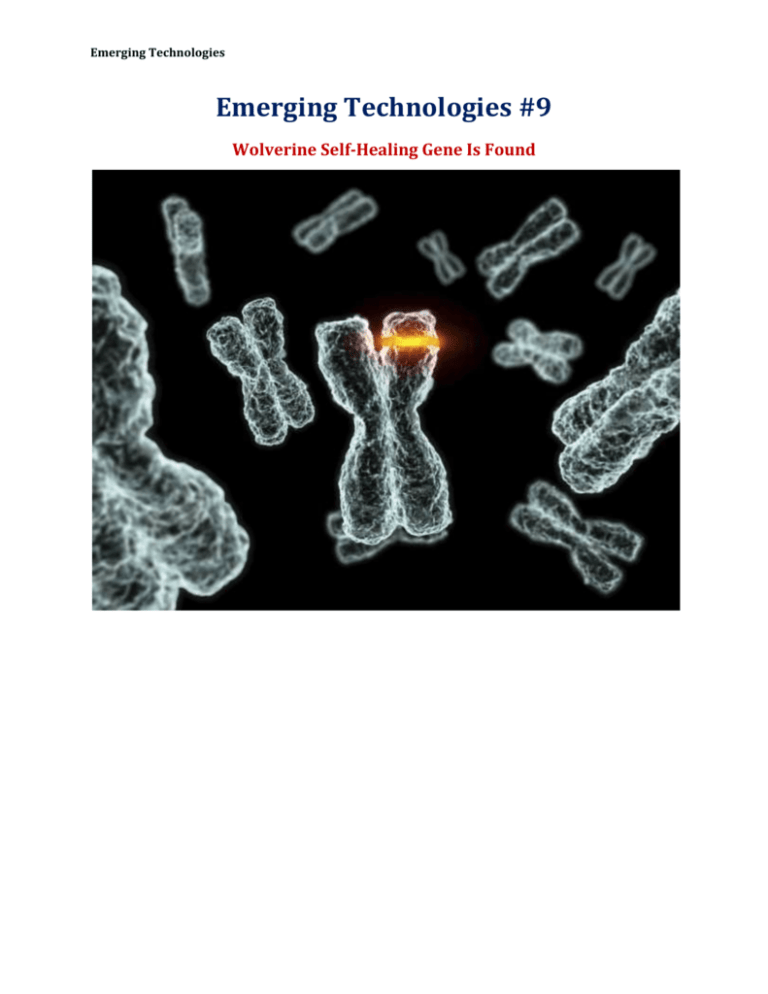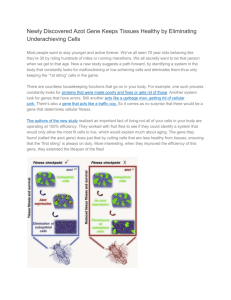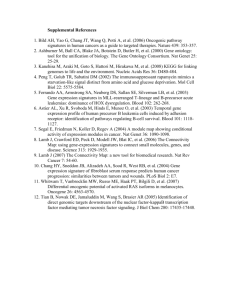Section 1 – Executive Summary
advertisement

Emerging Technologies Emerging Technologies #9 Wolverine Self-Healing Gene Is Found Emerging Technologies Table of Contents Section 1 – Executive Summary ........................................................................................................................ 3 Section 2 – Related News & Articles ................................................................................................................ 4 Article 1. 'Fountain of youth' gene is discovered - and scientists say it could help heal wounds ............4 Article 2. Wolverine Self-Healing Gene Is Found............................................................................................................5 Article 3. Self-heal like Wolverine? Gene discovery might hold clues ..................................................................6 Emerging Technologies Section 1 – Executive Summary Wolverine Self-Healing Gene Is Found One Harvard researcher thinks he has found the gene that would enable us to regrow organs and regenerate limbs. While conducting cancer research, Daley clipped holes in ears of mice that were genetically engineered with the Lin28a gene so he could quickly tell them apart from the control group. But the holes kept healing. So he clipped their toes, but they grew back. He then waxed their backs, but their fur grew back more quickly than usual. It appeared that Lin28a, a gene that scientists think regulates the self-renewal of stem cells -- gave the mice special regeneration abilities. "It sounds like science fiction, but Lin28a could be part of a healing cocktail that gives adults the superior tissue repair seen in juvenile animals," said Daley, lead author of a study that appears in the November 7 issue of Cell. The team "found they could replicate the healing abilities of the engineered mice by giving nongenetically altered ones drugs that help activate certain metabolic processes -- the same pathway Lin28a stimulates -- revving up and energizing cells as if they were much younger," Scientific American explains. The findings reveal that at least part of the reason that most animals cannot regenerate lost limbs lies in their metabolism. When Lin28a turns on and expresses a protein in the body, it boosts the metabolism, apparently fooling the body into thinking that it is younger and spurring a complex cascade of chemical reactions that generate energy. The research shows how the same mechanisms that ordinarily provide cellular energy can also drive more exotic processes such as wound healing. Their studies support the concept that mammalian tissue repair can be substantially improved by engineering the reactivation of genes that regulate juvenile developmental stages. Emerging Technologies Section 2 – Related News & Articles Article 1. 'Fountain of youth' gene is discovered - and scientists say it could help heal wounds Source: http://www.dailymail.co.uk/health/article-2490853/Fountain-youth-gene-discovered--scientists- say-help-heal-wounds.html (07/11/2013) The gene, Lin28a, is highly active in unborn children, but does less with age Harvard researchers now hope that waking the gene up in adults could speed healing of wounds after operations They say it may also be possible to create a drug that works in the same way A ‘fountain of youth gene’ has been identified by scientists. Experts have long been puzzled as to why young animals recover from injuries more quickly than adults. The gene, Lin28a, is highly active in unborn children, but does less and less with age. In tests on mice, it quickened the healing of wounds and sped up regrowth after a patch of fur was shaved. It also helped repair tissues in the ear after they were injured. Lin28a achieved all of these effects by increasing the production of several metabolic enzymes and enhancing metabolic processes that are normally more active in embryos. The Harvard Medical School scientists hope that waking the gene up in the adult body could speed up the healing of wounds after operations. Researcher George Daley said it may be possible to produce a drug that has the same effect as the gene. He added: ‘It sounds like science fiction but Lin28a could be part of a healing cocktail that gives adults the superior tissue repair seen in juvenile animals.’ He said: ‘Why some animals can fully regenerate organs when others cannot is a longstanding mystery of biology. ‘Our studies support the concept that mammalian tissue repair can be substantially improved by engineering the reactivation of genes that regulate juvenile developmental stages.’ Emerging Technologies Article 2. Wolverine Self-Healing Gene Is Found Source: http://techbeat.com/2013/11/wolverine-self-healing-gene-found/ (11/11/2013) One Harvard researcher thinks he has found the gene that would enable us to regrow organs and regenerate limbs. Various genes in our bodies turn on and off and different times over the course of our lives. It is here that scientists are looking for the magical code that would allow us to self-heal. George Daley of Harvard Medical School was conducting an identification technique for his lab rats. The procedure included the action of clipping the ears or tips of the toes of the mice. Daley noticed that the ears and toes of these little mice would grow back in a matter of days. The reason for this was because these particular mice had been genetically engineered so that a gene that helps them grow in the womb would continue to work after birth, effectively never turning off. This gene is called Lin28a and by boosting metabolism, it can trick the body into thinking it is younger than it actually is. Daley and his team have confirmed that Lin28a can indeed regrow parts of body parts. There are some limitations however. “The power of Lin28a appeared to only extend so far. When mice were no longer babies—at five weeks— the scientists were not able to regenerate their limbs, even if the gene was stimulated. And mice with Lin28a activation were never able to repair damage to the heart, suggesting that the protein is not equally effective everywhere in the body.” So we can conclude that Lin28a does not last forever and it does not work for all body parts. Despite these limitations, there is still hope for finding other genes. The scientists have learnt that bodily healing can be controlled by manipulating metabolic processes and so now they know where to look, they can focus their efforts on finding other genes that might be involoved. Although full limb regeneration may still be way in the future, this discovery certainly brings us one step closer to being able to regenerate like Wolverine. Emerging Technologies Article 3. Self-heal like Wolverine? Gene discovery might hold clues Source: http://news.cnet.com/8301-11386_3-57611793-76/self-heal-like-wolverine-gene-discovery-mighthold-clues/ (11/11/2013) In a discovery by a Harvard researcher, a reactivated gene found in embryos helps mice regrow clipped parts of their ears and toes. Could the "fountain of youth" gene hold promise for humans too? If scientists can clone sheep and 3D-print human ears, surely they can figure out how to make our bodies heal themselves like Wolverine's does. Thanks to a curious accidental discovery from Harvard Medical School and Boston Children's Hospital researcher George Daley, we may be closer than we previously thought. While conducting cancer research, Daley clipped holes in ears of mice that were genetically engineered with the Lin28a gene so he could quickly tell them apart from the control group. But the holes kept healing. So he clipped their toes, but they grew back. He then waxed their backs, but their fur grew back more quickly than usual. It appeared that Lin28a -- a gene that scientists think regulates the self-renewal of stem cells -- gave the mice special regeneration abilities. "It sounds like science fiction, but Lin28a could be part of a healing cocktail that gives adults the superior tissue repair seen in juvenile animals," said Daley, lead author of a study that appears in the November 7 issue of Cell. Aside from any "Rats of NIMH" flashbacks many of us might be having from this description, it's worth considering the scientific significance of Daley's accidental discovery. The team "found they could replicate the healing abilities of the engineered mice by giving nongenetically altered ones drugs that help activate certain metabolic processes -- the same pathway Lin28a stimulates -- revving up and energizing cells as if they were much younger," Scientific American explains. The findings reveal that at least part of the reason that most animals cannot regenerate lost limbs lies in their metabolism. When Lin28a turns on and expresses a protein in the body, it boosts the metabolism, apparently fooling the body into thinking that it is younger and spurring a complex cascade of chemical reactions that generate energy. The research shows how the same mechanisms that ordinarily provide cellular energy can also drive more exotic processes such as wound healing. Emerging Technologies For now, the scientists only observed the healing power of Lin28a in baby mice and couldn't replicate the same limb regeneration in mice past 5 weeks old. "This is a gene that has now stimulated tremendous interest, and that is a testimony to its central role in many areas of biology," Daley said. But while humans can already regenerate fingertips, spurring human regenerative abilities with the gene remains a long way off -- no drugs are known to effectively turn Lin28a on in humans. "This is exciting and illuminating research on the principle of regeneration," Daley said. "I hope it will stimulate other research that would have clinical implications." The research may indeed be exciting, but since we won't all be turning into X-Men mutants tomorrow, we suggest taking good care of yourself and not picking fights with Deadpool.









